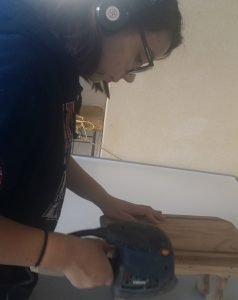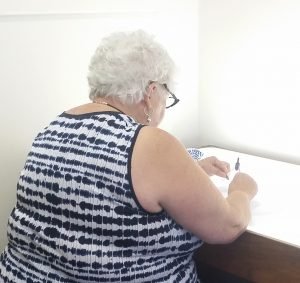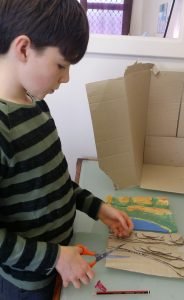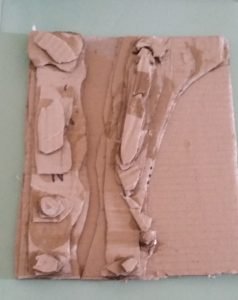Characteristic #24 The tasks of the catechist include:
- to go deeper into the Christian message through the knowledge of the biblical and liturgical sources and of ongoing living tradition of the church, including the theological, social and ecumenical movements which enliven the church today;
- preparing an environment and maintaining order in that environment (the atrium) so that it fosters concentration, silence and contemplation in both the child and adult;
- preparing the materials oneself as much as possible while collaborating with others in areas that are beyond one’s abilities.
Part 3
Our final part in looking at the 24th Characteristic of the Catechesis of the Good Shepherd is that of materials preparation.
 A few things come to mind when thinking about preparing materials with our hands. The first is our belief in our own abilities. The second our individual skills. Thirdly our time. The fourth costs. I would like to consider each of these in this post.
A few things come to mind when thinking about preparing materials with our hands. The first is our belief in our own abilities. The second our individual skills. Thirdly our time. The fourth costs. I would like to consider each of these in this post.
Firstly our belief in our abilities. I am a person who enjoys doing things with my hands. Even when I was a child I enjoyed making things. When you make something for your own enjoyment and satisfaction, there is less pressure to “get it perfect” or for it to “work out” how you saw it in your mind. However, when you are making this for someone else or for public display, we like to get it perfect. We don’t want to let other people down or make it not fit for purpose. All admirable qualities considering these materials will be tools of the Holy Spirit!
This brings to mind the parable of the talents. It is easy to play it safe but by risking making something less than perfect we often find that God blesses us 100 fold for our effort. I think part of the challenge in having a go at making materials is our cultural belief in speaking less of our own abilities. This is somehow meant to make us appear humble. True humility is in seeing things truthfully. I think that acknowledging out gifts is as important as acknowledging our weaknesses, and for many of us both of these things are difficult.
Once we get over ourselves it is time to decide how to make materials. For most of us it is not beyond our ability to copy or trace things for the handworks. We may need to focus on our neatness in our handwriting or in getting the spacing right but overall this is one of the easier tasks. I recommend using paper and pens etc. that are of good quality or the best you can afford. This will help you to get a better result.

Woodwork is often an obstacle for people, especially when a lot of these handwork crafts have gotten lost over the years. I marvel at Sofia making all the materials by hand when she was primarily a scholar! As they say, necessity is the mother of invention! I think one of the best gifts my husband bought for me is a scroll saw. It is a little like using a sewing machine (which I have used – thanks Mum for teaching me). What it enables you to do is cut our shapes (like sheep and merchants) from pieces of wood with relative ease. Again, I suggest getting the best wood you can afford as you only want to do this once as it is time consuming and the better quality you make it the longer it will last. The cgsusa.org website has some good tips for making boxes and dioramas which I recommend you have a look at and there are also loads of youtube videos to teach yourself most skills you will need.
For some of the materials you need to sew. As mentioned I have a sewing machine and some experience. Even so, a good pattern and nice fabrics help to get a good result with this. Some of the things like vestments also need a stand. We have various stands from “T” shaped pieces of wood to papier mache busts. I suggest just take your time and let your inner engineer out and have a go as much as you can.

There are some online resources you can purchase, but I would strongly recommend to only buy ready made materials as a last resort. The children are drawn to the uniqueness of the handcrafted materials. They see so much manufactured in their world that they easily recognize the love and care that has been taken to make this just for them. It also invites them to have a go themselves. I have one level 3 child currently working on making his own raised surface map of the land of Israel.

When painting your materials recall that this material will be used for a prayerful purpose. We do not want the materials to draw the child away from the scripture (for example) that it is highlighting but rather to draw them into it. Steer clear of being too cutesy or over embellishing. This is definitely a case of less is more! However, adding elements that attract the child to the work are useful (attract not detract). It would be suitable, for example, to paint the chalice in the last supper gold, but not suitable to give characters to each of the apostles. In painting I would also recommend using a base coat to help the colours stand out from the wood and then using some clear coat to finish them off after painting in the details.
One of the costs involved in making materials is our time. We live in a time where we are used to having everything instantly. We also try to use every moment doing something and feel like we are wasting time if something takes longer than expected. I think this is one of the reasons we are encouraged to make our own materials. We get first hand experience in slowing down and being in the moment. Of pondering the works these materials help to depict. What a beautiful meditation it is to paint Mary’s house, to think of how she lived. What sort of a life did she lead? What would she have been doing in the house when the angel came to visit her? All the same questions we ponder with the children! It is the time taken to make the materials and then prepare the album pages that are the times where we prepare ourselves to proclaim the word to the children. It does take time, but like the leaven our time and work will be rewarded by growth.
The final obstacle we may have in materials preparation is that of financial cost. This is one of the biggest hurdles many catechists face. Without the backing from a larger group such as the parents or the parish, it can be extremely difficult to prepare all of the materials. Some things can be acquired relatively easily and cheaply from second hand or charity stores, such as chalices and patens and small tables (look for goblets or silver or brass liqueur glasses, small plates or lids or coasters, coffee tables and so on). Most practical life materials are easily found this way also. For the sandpaper globe, just find a small globe (you can sometimes get these at discount shops for quite cheap prices) and paint over the continents with wood glue and coat with sand. Then after that paint over the oceans in blue and the land in tan. You may want to paint a sealer on top to protect it. It is quite easy to do.
Purchasing wood can become expensive. I suggest get creative. Find someone who can donate offcuts to you. You may be able to make use of old pallets or even old furniture to cut up and make into the various dioramas. When created the 3D figures you may feel you need to buy peg dolls and they can be reasonably priced or quite expensive depending on how many you need to purchase and costs for postage etc. Consider instead buying a wooden broom handle and cutting off lengths of these to make the shape of some of the characters. You will want to round off the tops and then they should be as enticing as any peg dolls and quite a lot cheaper.
Lastly, I think you need to use the resource of your community. By asking parishioners and parents to contribute time, expertise and money into building the atrium you are also building a community who own the work as much as the catechist and will then support it as the years go on.
The Catechesis of the Good Shepherd is a work not only for children but for the whole community to build a place where everyone can encounter Jesus the Good Shepherd and grow in their gifts through the Holy Spirit.